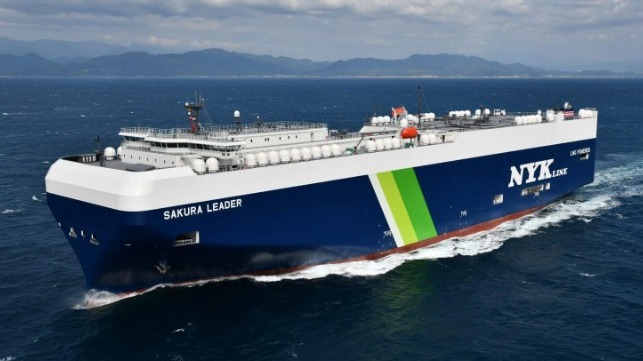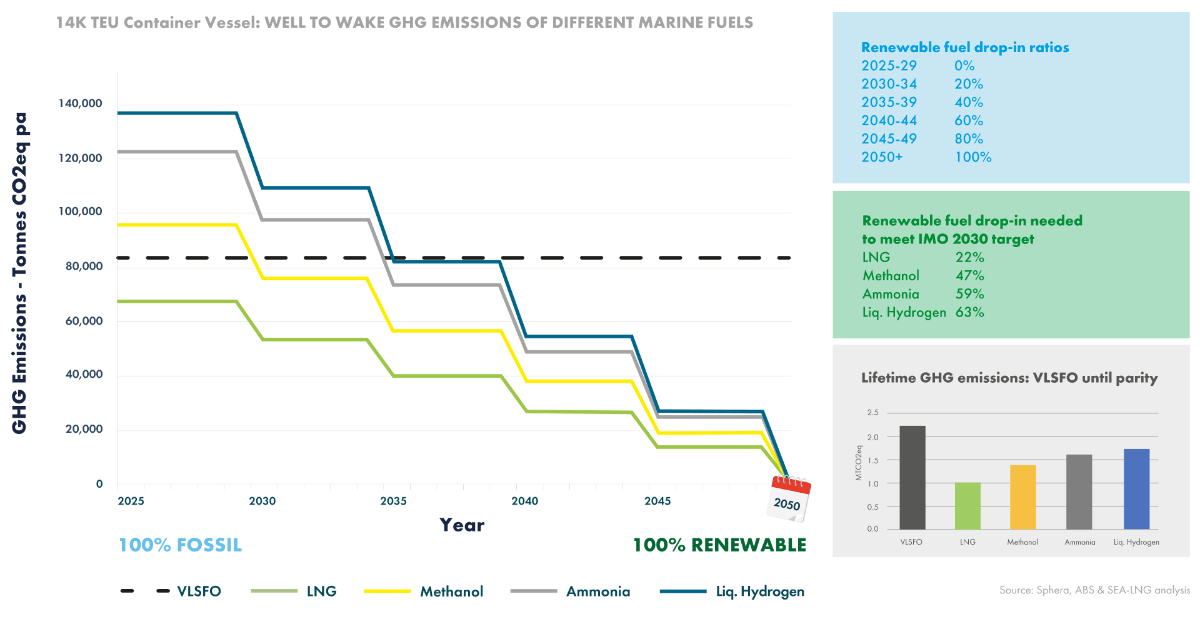Op-Ed: Understanding the Full Lifecycle Emissions of Alternative Fuels

 All alternative marine fuels share a common decarbonization pathway beginning with fossil or fossil-derived fuels, also known as "gray” fuels, and ending with renewable synthetic e-fuels, also known as “green” fuels. For some fuels, this pathway also includes a biogenic fuel mid-point.
All alternative marine fuels share a common decarbonization pathway beginning with fossil or fossil-derived fuels, also known as "gray” fuels, and ending with renewable synthetic e-fuels, also known as “green” fuels. For some fuels, this pathway also includes a biogenic fuel mid-point.
While fuels share a common pathway, they are all at differing points on that path in terms of technological and operational readiness, safety or commercial availability. Given this, it is essential to compare the emissions, cost and safety implications of each on a like-for-like, apples-to-apples basis. The industry is making newbuild investment decisions now that will impact greenhouse gas emissions today and for the next 25-30 years, the typical lifecycle of a vessel. Any ambiguity in alternative fuel analysis risks delaying or hindering decarbonization.
All pathways start with fossil
Discussion of alternative fuels too often compares the green versions of ammonia and methanol with fossil, or gray, LNG. The reality is that all e-fuels will only become available as and when sufficient renewable electricity and electrolysis capacity to supply a zero-carbon hydrogen feedstock comes online. Most suggest that this is at least a decade away and even then, quantities are questionable. In the meantime, fossil-derived or biogenic fuels must be used.
All alternative fuels available today are fossil-based, typically produced from a natural gas feedstock. This includes LNG, which is natural gas cooled to the point of liquefaction. Natural gas, and occasionally coal, are the feedstock for almost all current methanol, ammonia and hydrogen production. Fuels produced in this way are “gray," and should be identified as such. SEA-LNG has produced a graphic which illustrates the transition pathway for each fuel, highlighting the stages of development through fossil and biogenic fuels to e-fuels.
 Figure 1: All alternative fuels share a common pathway; shipping must make like-for-like comparisons
Figure 1: All alternative fuels share a common pathway; shipping must make like-for-like comparisons
Uniquely, fossil LNG offers significant greenhouse gas emissions reduction when used as a marine fuel compared with VLSFO – up to 23 percent on a full lifecycle (Well-to-Wake) basis according to an independent study by Sphera. By contrast, the use of fossil-derived methanol, ammonia and (liquid) hydrogen results in emissions far higher than those associated with VLSFO because of the large amounts of energy required for their production. This limits the commercial availability of these alternative fuels and slows technology development, as owners continue to use traditional oil-based fuels that emit fewer GHGs.
Transitioning to biogenic fuels
Decarbonization will be a gradual process. The industry will not experience a “big bang" move from fossil to zero-emission, renewable fuels. Decarbonization pathways will be incremental as low and zero-emission drop-in fuels are developed. As the availability and use of these drop-in fuels increases and they are blended with fossil-derived fuels, emissions will be reduced over time in step with the tightening of global regulations.
Already, emissions can be significantly reduced using fuels derived from sustainable biomass, such as human or agricultural waste. This is particularly the case for bioLNG which is being used as availability allows by some operators. There are also some opportunities for biomethanol. For other alternative fuels, this biogenic mid-point is unlikely to ever exist at scale.
BioLNG, as a marine bunker fuel, is already commercially available in Europe today and has been used in North America. It has penetrated the heavy-duty vehicle road transportation sector in both Europe and North America. While biomethanol also exists in limited quantities, it is mainly used as an industrial chemical feedstock.
Analyze the pathway, not only the destination
To illustrate the implications of fuel pathways for the climate and for shipowners, SEA-LNG developed an example investment decision illustrating a duel-fuelled 14,000 TEU container vessel coming into operation in 2025 and operating for 25 years in a market for e-fuels that is increasing in scale from 2030 onwards.
 Figure 2: Comparing alternative fuel pathways for a dual-fuel 14,000 TEU container vessel
Figure 2: Comparing alternative fuel pathways for a dual-fuel 14,000 TEU container vessel
Modeling the emissions over the life of the vessel we note that LNG offers immediate GHG reductions decreasing to zero-emissions by 2050. The bar chart shows a reduction in cumulative emissions over the lifetime of the vessel, measured on a well-to-wake basis. The reduction for the LNG pathway is more than 50 percent compared with VLSFO; for methanol and ammonia the corresponding reductions are 37 percent and 28 percent respectively.
The methanol and ammonia pathways offer lifetime emissions reductions in this same scenario, but these are smaller because their pathways do not offer a net emissions reduction compared with VLSFO until at least 2030. Emissions for gray methanol are 14 percent higher than VLSFO on a well-to-wake basis and 47 percent higher for gray ammonia. This is likely to mean owners and operators choosing methanol and ammonia pathways will be forced to continue using VLSFO until green versions are available at scale, postponing significant reductions of GHG emissions for several years.
To achieve emissions parity with LNG, fossil-derived methanol and fossil-derived ammonia will need to be blended with approximately 30 percent e-methanol and 50 percent e-ammonia. These fuels will not be available at scale until well into the next decade. The gray versions of methanol and ammonia are currently not cost competitive with LNG and the green versions are likely to cost significantly more. None of this includes the costs associated with creating the new bunkering infrastructure necessary to support these green fuels, when and if they can be commercially and safely produced and made available at scale.
Waiting is not an option
We know the industry cannot wait, but making inaccurate comparisons between e-fuels that are not yet fully developed and low-emission fossil fuels that are currently available in abundance, impedes our decarbonization efforts. LNG provides benefits now, not only in carbon reduction but air quality. LNG also has a clear pathway forward to net-zero.
The Shipping Industry needs to assess fuel pathways based on how they can deliver decarbonization benefits now as well as in the future. This must be done on a real lifecycle basis within the context of the safety, energy density and sustainability of the pathway chosen and the long-term investments required.
When we compare apples to apples, it becomes clear that the LNG pathway provides a practical and viable route to zero-emissions shipping that can start right now. There is no need to wait as that is not an option.
Peter Keller is the chairman of SEA-LNG, a multi-sector industry coalition established to demonstrate the benefits of the LNG pathway to decarbonization.
The opinions expressed herein are the author's and not necessarily those of The Maritime Executive.
